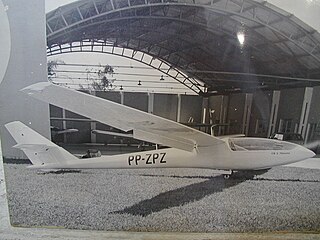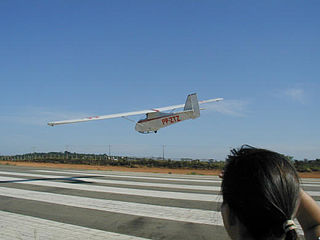Related Research Articles

The Zivko Edge 540 manufactured by Zivko Aeronautics is a highly aerobatic aircraft. Capable of a 420 degree per second roll rate and a 3,700 foot per minute climb rate, it has been flown to victory on the international Unlimited aerobatics circuit several times since the mid-1990s. A tandem-seat version is sold as the Edge 540T.

The Call-Air Model A is an American two- to three-seat utility aircraft designed by the Call brothers and built by the Call Aircraft Company, later developed into a successful line of agricultural aircraft.

The CNNA HL-6 was a civil trainer aircraft developed in Brazil in 1943.
The Preceptor STOL King is an American STOL amateur-built aircraft that was designed and produced by Preceptor Aircraft, of Rutherfordton, North Carolina. When it was available the aircraft was supplied as plans or as a kit for amateur construction.

The CEA 102 CB.2 Minuano is a high performance sailplane designed by Claudio Barros and developed by the Centro de Estudos Aeronáuticos - at the Escola de Engenharia da Universidade Federal de Minas Gerais (EEUFMG) - in Brazil between 1969 and 1975.
The Carlson Skycycle is an American, single-seat, low-wing, single-engine, homebuilt aircraft that was originally designed by A. Hanford Eckman in 1945 and re-designed as a replica by Ernst W. Carlson and produced by Carlson Aircraft of East Palestine, Ohio in kit form. The prototype was completed in 1995.

The Rhein-Flugzeugbau RF-1 was a prototype channel wing aircraft.
The Normand Dube Aerocruiser Plus is a four-seat Canadian amateur-built aircraft, designed by Normand Dube and produced by Aviation Normand Dube of Sainte-Anne-des-Plaines, Quebec. The aircraft is a development of the two-seat Norman Dube Aerocruiser.

The Backcountry Super Cubs Mackey SQ2 is an American STOL amateur-built aircraft, designed and produced by Backcountry Super Cubs of Douglas, Wyoming. The aircraft is based upon the design of the Piper PA-18 Super Cub and is supplied as a kit for amateur construction.
The Backcountry Super Cubs Supercruiser is an American amateur-built aircraft, designed and produced by Backcountry Super Cubs of Douglas, Wyoming. The aircraft is based upon the design of the Piper PA-12 Super Cruiser and is supplied as a kit for amateur construction.

The Backcountry Super Cubs Super Cub, also referred to as the Supercub replica, is an American amateur-built aircraft, designed and produced by Backcountry Super Cubs of Douglas, Wyoming. The aircraft is based on the design of the Piper PA-18 Super Cub and is supplied as a kit for amateur construction.

The Fly-Fan Shark is a Slovak light aircraft designed by Frantisek Sustek and initially developed by Fly-Fan of Trenčín. Development continues under the new owner of the design, AENEA Services. The design was introduced at the AERO Friedrichshafen show in 2007 as a mock up and in 2011 as a flying aircraft. The aircraft first flew on 29 June 2011 and is intended to be supplied as a complete ready-to-fly-aircraft.
The Sea Storm is an Italian homebuilt amphibious flying boat that was designed and produced by Storm Aircraft of Sabaudia. Storm Aircraft was originally called SG Aviation srl. When it was available the aircraft was supplied as a kit for amateur construction.
The St Croix Sopwith Triplane is an American homebuilt aircraft that was designed and produced by St Croix Aircraft of Corning, Iowa. When it was available the aircraft was supplied as a kit or in the form of plans for amateur construction. The aircraft is a full-size replica of the 1916 Sopwith Triplane fighter aircraft.

The SkyDancer SD-260 was an American aerobatic homebuilt biplane that was designed and produced by SkyDancer Aviation of Louisville, Kentucky, introduced in the mid-1990s. When it was available the aircraft was supplied as a kit.

The Starfire Firebolt, sometimes called the Starfire Firebolt Convertible, due to its removable canopy, is an American homebuilt aerobatic biplane that was designed by G. H. "Mac" McKenzie and produced by Starfire Aviation of Tempe, Arizona. When it was available the aircraft was supplied in the form of plans for amateur construction, with some pre-fabricated parts available.
The Tech Aero TR 200 is a French homebuilt aerobatic aircraft that was designed and produced by Tech Aero of Glisolles, first flown in August 1988. When it was available the aircraft was supplied as a kit for amateur construction.

The CEA-101 CB.1 Gaivota, is a single-seat sailplane of high-wing construction designed in 1963 in Brazil.
The IPAI-26 Tuca was a Brazilian single engined high-wing light utility aircraft.
The CEA-308 is a Brazilian sports aircraft designed by Paulo Iscold, that beat four FAI World Records with pilot Gúnar Armin Halboth.
References
- ↑ Simons, Martin (2005). Sailplanes 1965 - 2000 . Königswinter: EQIP Werbung & Verlag GmbH. pp. 16–17. ISBN 3 9808838 1 7.
- ↑ Paulo Iscold. "Using Experimental Aircrafts[sic] to Teach Aeronautical Engineering". Federal University of Minas Gerais . Retrieved 15 October 2021.
- ↑ "Acrobacias acadêmicas". São Paulo Research Foundation . Retrieved 15 November 2021.
- ↑ "FAA Order JO 7360.1E Aircraft Type Designators" (PDF). Federal Aviation Administration . Retrieved 15 October 2021.
- ↑ Fiuza, Marcelo (14 Oct 2009). "Projeto de extensão da UFMG produz avião de acrobacias (in Portuguese)". O Tempo (in Portuguese). Contagem.